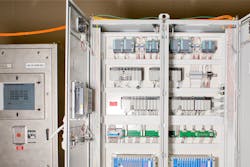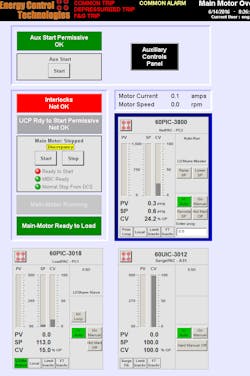LNG facility installs open and integrated turbomachinery control platform
The U.S. is already the leading shale gas producer, and production is expected to grow from 37 billion cubic feet per day (Bcf/d) in 2015 to 79 Bcf/d by 2040. Energy Control Technologies (ECT), an original equipment manufacturer (OEM) member of the Rockwell Automation PartnerNetwork program, is one company that helps drive this relatively recent energy boom. The Iowa-based company designs, builds and supports turbomachinery plant control systems for oil and gas production. Its anti-surge and performance-control solutions are used in applications ranging from gas production and offshore platforms to refining and pipelines.
One company recently selected ECT to develop the turbomachinery control for gas compressors at a new, U.S.-based liquid natural gas (LNG) pretreatment facility. The facility’s project presented a new challenge: deliver the turbomachinery control platform in an open and integrated solution instead of using the traditional proprietary-systems, or “black-box” approach.
High-availability turbomachinery
The turbomachinery control system was for two trains, each with three parallel compressors. Because the operations will be expected to run continuously for years at a time, a redundant architecture was essential to ensure that a backup system would take over and reduce the likelihood of downtime should a failure occur.
The turbomachinery required a hardware platform for the compressor controls with a Safety Integrity Level (SIL) rating of 2. The auxiliary systems required a SIL-3-rated hardware platform for the motor cooling, lube oil and seal gas skids, and overall management of system trips, interlocks and permissives. Finally, the project required condition monitoring of vibration and bearing temperatures for all the equipment.
This project also needed to integrate the six compressors’ control systems with a single-motor, soft-start system. To meet this unusual requirement, a redundant programmable logic controller was added to manage the sequencing and interlocks necessary for all six of the compressors’ electric motors to share a single-load, commutated inverter soft starter.
Traditionally, developing a high-availability, turbomachinery control platform of this magnitude requires combining multiple proprietary systems from different vendors. However, that approach comes with several inherent challenges.
“The different systems often don’t natively talk to each other, which makes integration more challenging and time consuming,” said Tom Stoll, senior project engineer for ECT. “Also, piecing together different proprietary systems can make life more difficult for end users in several ways. It requires maintenance technicians to learn and service a wider range of systems or outsource maintenance to multiple vendors. It requires operators to learn and work with different HMIs, and it requires companies to purchase and manage more spare parts.”
ECT’s client wanted to avoid these challenges by relying on a single vendor to combine the systems into a single, integrated solution using open-architecture, industry-standard technology.
Designing an integrated alternative
Delivering an easy-to-use system with this breadth of scope meant that ECT needed to use an automation technology that leverages open-architecture standards. The company used the PlantPAx DCS from Rockwell Automation. The technology is based on open-communication standards and can serve as a common automation platform by connecting process, discrete, power, information and safety controls.
For the turbomachinery applications, this system provided a SIL-2-rated platform for compressor control. The hardware leveraged add-on instruction capabilities and delivered execution speeds equal to or better than proprietary systems. ECT also incorporated its patented, surge-control software, which used algorithms to help detect and prevent potentially damaging surges in the compressor. Integrated human machine interface (HMI) software from Rockwell Automation was used for the operator interfaces.
“We also incorporated load-sharing as another critical application in the turbomachinery control system,” Stoll said. “The compressors work together to maintain a constant discharge pressure for the compressor network. Load-sharing also allows the customer to bring individual machines on-line or off-line to accommodate changing demands without disturbing the overall process.”
For the auxiliary systems, ECT used the AADvance fault-tolerant control system to provide a SIL-3-rated hardware platform for sequencing and process control for auxiliary skids and system trips.
“If the lube-oil system [fails] or if cooling is lost on the motor, the AADvance [fault-tolerant control system] platform can trip the system and stop it before damage occurs,” Stoll said.
As part of the integration of the turbomachinery, auxiliary control and condition monitoring systems, the open-platform solution also provided a single connection to the plant distributed control system (DCS) via Modbus/TCP.
A simple solution with lower life-cycle costs
ECT’s open-platform design approach helped save time and reduce complexity in deploying its customer’s compressor solution while meeting or exceeding all specifications.
“The PlantPAx system and Modbus/TCP communications allowed us to integrate everything into a single platform,” Stoll said. “Had our customer gone with a proprietary solution, this would have required systems from as many as four different vendors. Just trying to get those systems to communicate with each other would have been a major project in itself.”
ECT estimates the solution could save its LNG gas customer about 50 percent in life-cycle costs. This includes reduced integration costs and lower support and operating costs.
“One system instead of four will mean fewer technologies for [personnel] to learn and maintain,” Stoll said. “It also reduces the number of spare parts that need to be stocked and managed to support the system, and it allows our customer to potentially bring maintenance activities in-house that they otherwise would need to outsource to several vendors in a proprietary-systems approach.”
The open and integrated design approach also will offer greater efficiencies when compared to a proprietary approach. For example, a proprietary solution would have required that operators work from as many as a dozen different panels and stations to initiate operations. The integrated platform will greatly simplify that process.
“It turned this very complicated sequence of getting the motor started into literally two button pushes for an operator,” Stoll said.
Also, because the platform’s control elements are integrated, operators and technicians can access any of them from a single HMI, rather using a different HMI for each system.
“With the PlantPAx solution, workers will be able to monitor overall production status, review a system’s performance, or look at trips and diagnostics – all from one screen,” Stoll said.
Author’s note: The results mentioned above are specific to Energy Control Technologies’ use of Rockwell Automation products and services in conjunction with other products. Specific results may vary for other customers. AADvance®, PartnerNetwork™ and PlantPAx® are trademarks of Rockwell Automation Inc.
Brad Conover has been with Rockwell Automation for 23 years in multiple sales capacities. He currently leads the engagement with Rockwell Automation partners in Iowa as part of the company’s channel organization. Conover is a graduate of Iowa State University and holds a Bachelor of Science in Mechanical Engineering.
Reference
“Shale Gas production drives world natural gas production growth.” U.S. Energy Information Administration. Aug. 15, 2016.


